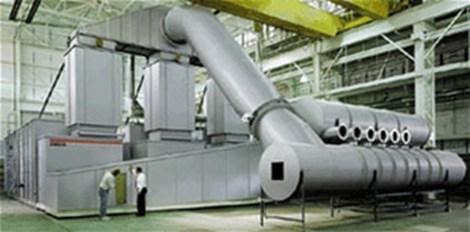 The Challenge
The Challenge
A major chemical manufacturer required a pollution control system to destroy the halogenated Volatile Organic Compounds (VOCs) emitted during the formulation of Purified Terephthalic Acid (PTA). During the production process, methyl bromide is converted to hydrogen bromide. The pollution control system had to be designed to withstand the corrosive nature of the hydrogen bromide as well as the varying organic loading, which alter the temperature of the abatement system.
The Solution
After a thorough supplier evaluation, the plant selected and contracted Anguil Environmental Systems to solve their VOC emission problem. Because of the high loading of CO and the presence of methyl bromide, Anguil recommended a Catalytic Recuperative Oxidation System. It would utilize a specialized metallic catalyst specifically designed for PTA plant exhausts. Anguil’s success with catalytic oxidation of halogenated compounds and experience integrating control devices into existing processes were crucial factors in the plant’s decision.
 The Result
The Result
An Anguil catalytic oxidation system designed for 90,000 SCFM (144,450 Nm3/hr) was used to process the airflow. The presence of methyl bromide in the emission stream presented additional design considerations. The catalyst oxidizes the methyl bromide to hydrogen bromide (HBr). If hydrogen bromide drops below its dew point it becomes corrosive to the equipment. The equipment downstream of the catalyst must be engineered to avoid any “cool spots” where the hydrogen bromide can condense.
The heat exchanger is one potential “cool spot.” Without proper design, the heat exchanger could lower the temperature of the air exiting the catalytic oxidizer to below the dew point of hydrogen bromide. To avoid the potential condensation of hydrogen bromide and subsequent corrosion to the system, Anguil incorporated a steam pre-heater on the incoming process stream before the catalytic oxidizer. The exhaust from the PTA plant is heated with a 316L stainless steel plate and frame steam pre-heater. The preheated process air then enters the tube side of the shell and tube heat exchanger. The increased temperature of the process air entering the tube side of the heat exchanger prevents the condensation of HBr on the shell side of the heat exchanger, a critical issue in the overall design of the system.
The process exhaust from the PTA plant varies in organic loading; therefore, the catalytic oxidizer design must accommodate these varying levels with minimal use of auxiliary fuel. This is accomplished by utilizing a bypass on the 316L stainless steel shell and tube heat exchanger. Under low organic loading conditions, the heat exchanger bypass is closed so that the full effectiveness of the heat exchanger is available to preheat the incoming stream. At high organic loading, the outlet temperature of the catalyst is raised, resulting in a high preheat temperature from the heat exchanger. This high preheat temperature could cause overheating and shutdown of the system. The “hot side” heat exchanger bypass supplied by Anguil controls the preheat temperature from the heat exchanger, preventing any high-temperature conditions.
The selection of the proper catalyst that would oxidize both the carbon monoxide and the methyl bromide at low temperatures was critical to the project. Historically, halogenated compounds, which include chlorine, bromine, iodine and fluorine, have had damaging effects on both noble metal and base metal oxidation catalysts. Several significant advances in catalyst technology have occurred in recent years, resulting in the development of catalysts suitable for the air stream under consideration. A platinum/palladium-based catalyst deposited on a ceramic substrate was utilized in this design. Anguil’s proprietary catalyst rack design, including specialty gaskets, eliminated the risk of gas bypassing the catalyst which would result in incomplete destruction.
This Anguil Catalytic Recuperative Oxidation System is currently operating and achieving the regulatory compliance demanded of the PTA plant. With the success of this system, the customer purchased an identical 90,000 SCFM (144,450 Nm3/hr) unit and additional systems were installed for PTA manufacturers in the Middle East and Southeastern United States.

 The Challenge
The Challenge The Result
The Result